Community Paramedicine (CP) is much more than just at-home patient care. Throughout the years, within our communities -urban and rural- we have uncovered and understood the different needs of the population over time. Not only to serve the patient but also to support and improve the healthcare system.
As an initiative that proves to be not only effective but efficient, with benefits for communities across Canada, let’s understand what it is and the scope of action of Community Paramedicine.
What is Community Paramedicine?
To answer this question, we first need to build a better understanding of paramedicine.
Traditionally, when it comes to the practice of paramedicine, the top of mind is emergency response, such as responding to car accidents and heart attacks and bringing the ill and injured to the hospital. However, there are many more types of emergencies (an emergency is something a person perceives or experiences) and many “urgencies”; and paramedics are highly trained individuals equipped with many skills and tools that can perform many medical treatments and interventions.
Although the core role of a paramedic is within emergent and urgent situations, paramedics often find themselves working in what would be considered a non-urgent environment.
Statistically, we know that less than 18% of paramedic call volume is emergent/urgent, and approximately only 1% is life-threatening. That means more than 80% of what paramedics do is considered non-urgent. This has positioned paramedics as highly skilled healthcare practitioners to work within the community.
This brings us back to the question; what is Community Paramedicine?
Community Paramedicine is where paramedics utilize their skills and scope of practice with a different goal and focus. Instead of focusing on providing treatment in emergency situations and transporting to the hospital, the focus is providing treatment in urgent and non-urgent situations with the goal of health promotion, keeping individuals safely in their homes, and not transporting to the hospital.
Paramedics will always have the emergent component of their work, but as you can see, the paramedic is well-positioned to provide this sort of community care. It is a win-win situation.
Through collaborative efforts with health teams and the different health homecare systems, individual and community health can be improved. Patients can receive healthcare in their homes and remain in their homes. And the burden on our overtaxed hospitals can be reduced.
Many will ask, why paramedics? Don’t we already have other agencies doing this? The simple answer is paramedics have been practicing in the community for decades, but the result was always transporting to the hospital. What has changed is the goal to stay at home versus going to the hospital.
The paramedic’s role is changing not to replace the other agencies but to augment and support what they are doing.
Who is a Community Paramedic Practitioner?
All paramedics are community paramedics to some extent. This is an ever-evolving role for our acute-care paramedics. From making patient referrals for follow-up care after transport to the hospital to new ideas being considered/implemented such as alternative destinations (other than hospital emergency rooms) or treat-refer-release programs where care is provided on-scene, referrals to additional care are made, and the patient remains at home.
A Community Paramedic Practitioner is a paramedic that specializes in chronic and ongoing care.
A Community Paramedic Practitioner usually works by themselves in a non-ambulance vehicle and predominantly visits patients following a schedule of appointments or providing urgent (same day) care to patients enrolled in the Community Paramedic program.
Occasionally a Community Paramedic Practitioner will have a dual role of providing first response if an emergency occurs nearby or dual response if an ambulance responds to a Community Paramedic patient. But the core role is caring for a roster of enrolled patients.
Community Paramedics are firstly paramedics, are passionate about what they do, and are advocates for their patients and communities. Most have received additional specialized training in the practice of community paramedicine and the provision of chronic care.
Premergency’s Community Paramedic Training Program
Our training program aims to equip paramedics with the knowledge and skills required to apply their scope of practice within their community. The goal is to prepare paramedics for community practice by providing evidence-based training that fosters critical thinking skills, research, and leading practices, empowering them to support their communities with long-term care strategies in collaboration with health partners.
Premergency has utilized a problem-based learning (PBL) method of course delivery to accomplish this goal. PBL is an approach that allows active learning and the development of different skills towards solving a problem. It is designed to foster critical reflection and critical self-reflection leveraging real-life scenarios and group dialogue.
PBL aims to promote deeper understanding and critical thinking skills and prepares the paramedic for an independent collaborative, evidence-based practice. This is a postgraduate training program for paramedics and is 100% online, powered by ALEN.
Community Outcomes
The impact of Community Paramedicine initiatives responds directly to its goals: to promote health and prevent further disease or deterioration due to mismanagement of chronic illness; and help patients remain safe and healthy in their homes, allowing them to age at home to avoid the need for admission into long-term care.
Through initiatives such as Community Paramedicine and collaboration with existing systems, we can improve the health of our communities and mitigate the forecasted strain on our healthcare systems as a result of the ageing tsunami of baby boomers.
If you would like more information about the Community Paramedic training program or would like to register, click here.




